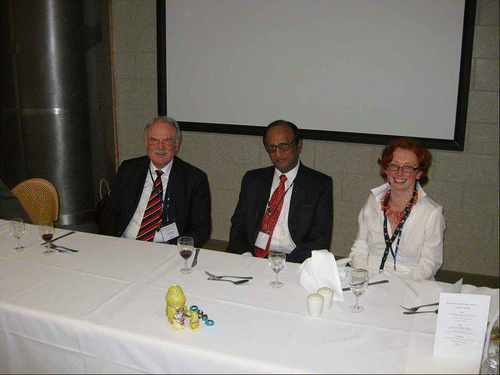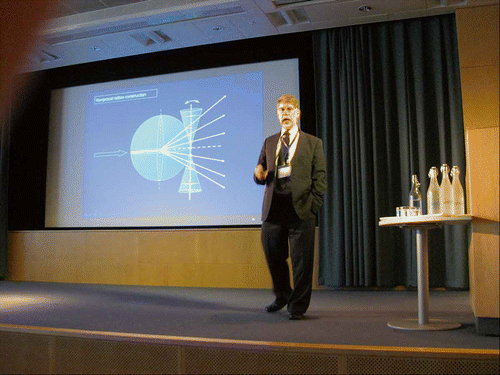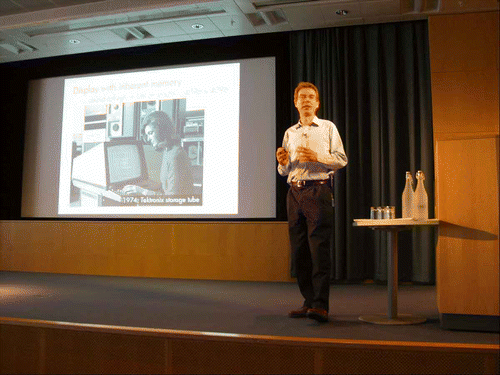British Liquid Crystal Society Annual Meeting, Bristol, April 2009
The 2009 Annual Conference of the British Liquid Crystal Society (BLCS) was held in Bristol at the Hewlett Packard Laboratories complex. This, the 23rd such meeting, was the first to be hosted by an industrial group – the facilities, organisation and atmosphere were very well received, and so we should not expect to have to wait until 2033 for another commercial group to be entrusted with the running of this meeting.
Following convention, the conference took place in the Easter break, running from 6 to 8 April 2009. It comprised seven sessions of talks plus a vibrant poster session. The material presented ranged from device applications through experimental and modelling methodologies to the fundamentals of molecular self-assembly.
The scientific programme opened after lunch on 6 April with an invited presentation by Adrian Giesow of HP Labs into electrophoretic and liquid-crystal-based bistable display devices (see ). This talk noted that a variety of approaches can yield bistability. It was stressed, however, that commercial interest is limited to those approaches that best exploit the applications areas for which bistability is particularly advantageous. Counter-intuitively, these areas generally involve relatively slow switching speeds and large driving voltages. Adrian also discussed routes to achieving greyscale in bistable devices. Following this, Mish Yakutovich from Sheffield Hallam showed how newly developed mesh-free modelling approaches can be used to study complex three-dimensional order fields, such as that found in HP's post aligned bistable nematic (PABN) device. The underlying mutiscale nature of these methods appears to make them very well suited to systems involving, for example, defect dynamics. This opening session was concluded by Giovanni Carbone from Oxford who showed how periodic polymeric microchannels can be used to stabilise the uniform laying helix structure. Prototype devices were shown to exhibit full modulation effects between light and dark states, with fast dynamic response and large contrast ratios.
The second session comprised three contributed talks. Firstly, Verena Görtz from York presented work she had performed developing liquid crystal elastomer microspheres. Here, birefringent particles of size 150 μm were obtained by cross-linking functionalised nematic monomers into polymeric microspheres. Following this, Alexandra Kohlmeier from Hull gave a talk on the phase behaviour of polyphylic block mesogens. Here, by exploiting a combination of hydrogen bonding and the fluorophobic effect, a rich array of smectic and cubic morphologies were obtained. These were then extended even further by complexation with various benzoic acids. To close the day's scientific programme, Martin Walker from York presented a comprehensive simulation study into the microstructured phases formed by bolaamphiphiles. In this, he showed that use of the dissipative particle dynamics simulation approach avoided the difficulties raised by metastability effects in these crowded and complex systems. Thus, a number of clear trends could be determined relating molecular structure to phase symmetry.
The opening talk on the second day was an invited contribution by Helen Gleeson from Manchester. She gave an overview of the science and technology associated with utilising laser tweezers on liquid crystalline systems. One aspect of this was the use of tweezers for metrology, particularly in relation to local viscosities and colloid–colloid forces. The second theme of this talk considered the use of laser traps to mechanically drive droplets of ordered fluid, culminating in a system in which the optical field induced periodic rotation and oscillation of a liquid crystal droplet. In the second talk of this session, Patrick Salter from Oxford presented his work on the development of a fluorescence microscopy technique for director profile visualisation. Through this, time-dependent profiles, taken at 2 ms intervals, had been obtained to illustrate the switching from the symmetric to the asymmetric H state. The third talk in this session was given by Sharon Jewell from Exeter. This related to flow measurement of liquid crystals in pressure-driven microfluidic channels. Using fluorescence confocal polarising microscopy to detect tracer beads in the flow, it was shown that two distinct flow and director profiles could be differentiated. The final talk of this session was given by Riccardo Barberi from Calabria and focussed on the electrically controlled biaxial order reconstruction. Here, this eigenvalue exchange effect was considered in the context of thin pi-cells, where it can be exploited to overcome a topological barrier in the field-induced switching process. This session was followed by an extended period set aside for posters and lunch. Over 40 posters were exhibited in the ambient atmosphere of The Street in the main HP Labs building.
The afternoon sessions opened with the 2009 Ben Sturgeon Lecture, given by Günter Lattermann from Bayreuth (see ). This concentrated on two aspects of Professor Lattermann's work – his pioneering developments in the field of liquid crystal dendrimer systems, with particular reference to the complexes they form with nanoparticles, and the development of nematic and cholesteric organogels. He emphasised that the principles underlying much of this work were that it exploited the combined effects of anisometry, aggregation and segregation so as to achieve the desired mesomorphisms. Self-organising liquid crystal–metal ion complexes were also the topic of the following talk by Valery Kozhevnikov from York. Her presentation focussed on synthetic and system-preparation issues relating to phosphorescent metal complexes, and how these can be used to control the emission wavelength. The relationship between self-assembly and colour were then addressed at an even more fundamental level by Mark Wilson of Durham, when he presented molecular dynamics simulation results for the chromonic dye system ‘sunset yellow’. As well as providing structural and interaction-strength information, these simulations indicated correlated dynamics in the dipoles of neighbouring molecules. Following on from this, Marina Sintyureva from Manchester presented an experimental study of a related chromonic system – copper phthalocyanine dye. Using a range of experimental approaches, particularly X-ray diffraction, the phase behaviours of these systems were mapped out and the underlying structural correlations associated with various phases were elucidated.
Figure 2. From left to right: Professor Lattermann who gave the Ben Sturgeon Lecture, Professor Sadashiva who received the 2009 George W. Gray Medal and Dr Susanne Klein of the organising committee.

The final session of this long day comprised three contributed talks. Philip Benzie from Oxford presented a study of the anchoring properties of organo-siloxane tetrapodes. In the absence of an applied field, this study found tilted uniaxial order, but switching to planar and homeotropic states was achievable using low- and high-frequency electric fields, respectively. In the next talk, Argyrios Karatrantos from Manchester presented a simulation and theoretical study into the isotropic–nematic transition of polyelectrolyte systems. Here it was shown that the stability of the nematic phase could be controlled by variation of the electrostatic interaction term. Lastly, Xiangbing Zeng from Sheffield presented experimental results on T-shaped bolaamphiphile systems. Here, a wide range of columnar, lamellar and bicontinuous structures were observed with variation of the molecular geometry and the temperature.
The conference dinner took place on the evening of 7 April. This featured fine food and drink, friendly service and, in a post-modern touch, table decorations of chocolate eggs, chicks and bunnies. Neither Duncan Bruce or Corrie Imrie were able to attend the meeting, so Martin Bates announced the year's main prize winners. The first of these was Bukkinakere K Sadashiva of Bangalore, the recipient of the 2009 George W. Gray Medal (see ). He gave a very modest and self-effacing acceptance speech, recalling his early days at the Raman Research Institute and making ground-breaking research sound quite matter of fact. The second prize-winner, awarded the Cyril Hilsum Medal, was Ingo Dierking of Manchester. This was a surprise to him and so he had no speech prepared – but he was certainly very happy to have his work recognised.
The final day of the meeting opened with a session on modelling, the first presentation being an invited talk from myself. This showcased a number of projects relating to the behaviour of particulate inclusions in liquid crystal systems and contrasted the role modelling contributed to each. Modelling can never reckon to capture full system behaviour. Here, though, I tried to show that appropriately focused studies can either examine and explain device behaviour or provide a spark to inspire novel experimental investigation. This was followed by a presentation from Amparo Galindo of Imperial College, London, who considered the ability of rod-disc mixture systems to exhibit biaxiality. Previous work on such systems had shown that such mixtures tend to phase separate rather than forming a single biaxial nematic phase, but Amparo's new results indicated that a parameter space does exist for which biaxial order remains stable. The third talk in this session, by Oliver Henrich from Edinburgh, won the prize for best oral presentation by a young scientist. The work described here involved large-scale lattice-Boltzmann simulation of the blue phases. By simulating temperature quenches on systems with different inherent chiralities, this work found a rich phenomenology of both long-range topology and shorter range domain symmetries. The final talk in this session was from Andrew Davidson of Strathclyde. This described recent advances he and his collaborators had made in applying conformal mapping techniques to liquid crystalline systems. This approach was shown to yield considerable computational speed-up in the calculation of director profiles to be used as initial conditions in more complex Q-tensor modelling.
The final session of the meeting opened with a talk from the host of the previous year's conference, Andrew Cammidge of UEA. Here, he reviewed studies on a range of triphenylene derivative systems and, more specifically, the general conclusions gleaned from these. By taking this broader view, he showed that, in fact, no globally applicable simple principles can be identified for these systems due to the strong interdependence of steric, conformational and electronic effects. As a consequence, it appears that reliable prediction cannot be assured. Following this, Kirsten Harth from Magdeburg gave a talk on the behaviour of inclusions in smectic films. She showed that, by studying such systems using both microscopy and numerical calculations, greater understanding could be gained into both the self-organisation of inclusions and consequent features such as coronae.
The twist in the tail of the conference was, as tradition dictates, an eloquent and multifaceted exposition from John Lydon (still at Leeds, despite repeated attempts to retire gracefully (see )). On this occasion, the focus of his reflections was a 1966 paper by Conmar Robinson on the cholesteric phases of synthetic polypeptides. What enthralled John about this work was its ‘reference list of cornucopia’ – ranging from Michelson, through iridescent beetle carapaces to Maurice Wilkins and de Vries. John's beautifully crafted tales of academe and polymath proved a welcome counterpoint to the usual conference chatter of referees reports and funding gossip.
Figure 3. It has become a well-established tradition at the British Liquid Crystal Conference that John Lydon always gives the last talk of the meeting. This is generally historically motivated, and ends with the recitation of a self-written poem relating to the topic of the talk.

The conference closed with universal thanks to the hosts, particularly Suzanne Klein and Chris Newton, for organising such a smooth-running and entertaining meeting and working, with their colleagues, to cope with all eventualities.
